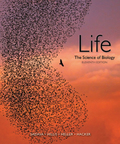
Concept explainers
To review:
The differentiation between radial symmetry and bilateral symmetry, protostome and deuterostome, and diploblastic and triploblastic.
Introduction:
Symmetry is defined as the repetitive body parts of plants and animals in a very ordered fashion. Different types of symmetry are exhibited by animals, such as asymmetry, radial, biradial, bilateral, and spherical. Depending on embryonic development, metazoans can be differentiated into protostomes and deuterostomes.
Protostomes are primarily primitive invertebrates, whereas deuterostomes include echinoderms and chordates. Germ layers are primarily layers of cells that are formed during embryogenesis. Some of the organisms have two germ layers and some have three and are diploblastic and triploblastic, respectively.
Want to see the full answer?
Check out a sample textbook solution
Chapter 30 Solutions
EBK LIFE: THE SCIENCE OF BIOLOGY
- An unidentified animal is noted to have simple tissues and possesses specialized cells called nematocysts. What is its overall body shape? Group of answer choices A. Asymmetrical B. Bilateral Symmetry C. Radial Symmetry D. Biradial Symmetryarrow_forwardDescribe the following general characteristics can be used to distinguish among Animal phyla: a. Embryonic germ layers b. Digestive system c. Presence/absence of body cavity (coelom) d. Skeletal supportarrow_forwardList the predominant body plan (acoelomate, pseudocoelomate, or coelomate) for members of each protostome phylum and discuss how our picture of protostome evolution would change if each body plan were a homologous characterarrow_forward
- Which of the following correctly describes the cleavage pattern in reptiles, birds, and fish? A. holoblastic,isolecithal,radialB. holoblastic, mesolecithal, radialC. meroblastic, telolecithal, discoidalD. meroblastic, telolecithal, bilateraarrow_forwardBriefly explain how radial symmetry and the lack of cephalization usually associated with it can have adaptive value for sessile animals and be favored by natural selection.arrow_forwardYou have received a number of embryos of a bilaterian animal from a colleague, who has asked for your help in determining the specific body plan of this animal. What type of symmetry is associated with the embryos that you received and why?arrow_forward
- Identify and label the parts of the following specimens of Phylum Nematoda:arrow_forwardFor phylum Mollusca, Class Cephalopod 1. Characteristics. List whether the organism is:a. Diploblastic or triploblastic (if applicable) b. Deuterostome or protostome (if applicable) c. Coelomate, pseudocoelomate or eucoelomate (if applicable) 2. Organ/system characteristics. Answer the following for each organism:a. How is their circulatory system? b. Excretory/osmoregulation: How does the organism eliminate waste? What organs do they use? 3. Ecology. Describe/answer the following for each organism:a. Does it have a complete or incomplete digestive system? How does this animal feed?b. Identify any unique feeding structure• Be sure to use the correct terms to identify any unique feeding structure(s) used by the animal.arrow_forwardWhat is the tissue origin of the following: Placoid ScalesCosmoid ScalesGanoid scalesCycloid scalesCtenoid scalesarrow_forward
- One of the challenges faced by animals when moving from an aquatic environment to a terrestrial environment is resisting the force of gravity that is constantly pulling down on an organism. Provide three different structural adaptations used by three different animal phyla (plural for phylum), which aid in resisting the pull of gravity on land, allowing the organism to maintain its body shape/structure. As part of your answer, make sure to include 1. The name of the organism (common name or genus) 2. The phylum the animal belongs to 3. The specific structural adaption and how it works to resist the pull of gravity on land. Edit View Insert Format Tools Table 12pt v Paragraph v В I ...arrow_forwardDefine metamorphosis.arrow_forwardDifferentiate the following according to their anatomical characteristics. Give at least five differentiation. a) Actinopterygii and Sarcopterygiiarrow_forward
 Concepts of BiologyBiologyISBN:9781938168116Author:Samantha Fowler, Rebecca Roush, James WisePublisher:OpenStax College
Concepts of BiologyBiologyISBN:9781938168116Author:Samantha Fowler, Rebecca Roush, James WisePublisher:OpenStax College
